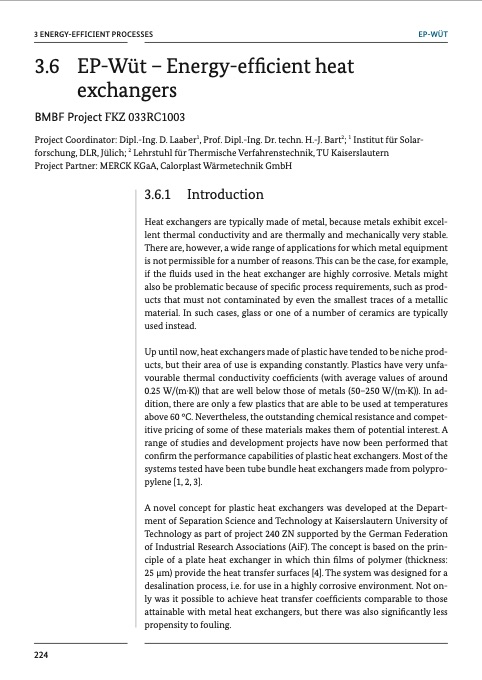
PDF Publication Title:
Text from PDF Page: 227
3 ENERGY-EFFICIENT PROCESSES EP-WÜT 3.6 EP-Wüt – Energy-efficient heat exchangers BMBF Project FKZ 033RC1003 Project Coordinator: Dipl.-Ing. D. Laaber1, Prof. Dipl.-Ing. Dr. techn. H.-J. Bart2; 1 Institut für Solar- forschung, DLR, Jülich; 2 Lehrstuhl für Thermische Verfahrenstechnik, TU Kaiserslautern Project Partner: MERCK KGaA, Calorplast Wärmetechnik GmbH 3.6.1 Introduction Heat exchangers are typically made of metal, because metals exhibit excel- lent thermal conductivity and are thermally and mechanically very stable. There are, however, a wide range of applications for which metal equipment is not permissible for a number of reasons. This can be the case, for example, if the fluids used in the heat exchanger are highly corrosive. Metals might also be problematic because of specific process requirements, such as prod- ucts that must not contaminated by even the smallest traces of a metallic material. In such cases, glass or one of a number of ceramics are typically used instead. Up until now, heat exchangers made of plastic have tended to be niche prod- ucts, but their area of use is expanding constantly. Plastics have very unfa- vourable thermal conductivity coefficients (with average values of around 0.25 W/(m·K)) that are well below those of metals (50–250 W/(m·K)). In ad- dition, there are only a few plastics that are able to be used at temperatures above 60 °C. Nevertheless, the outstanding chemical resistance and compet- itive pricing of some of these materials makes them of potential interest. A range of studies and development projects have now been performed that confirm the performance capabilities of plastic heat exchangers. Most of the systems tested have been tube bundle heat exchangers made from polypro- pylene [1, 2, 3]. A novel concept for plastic heat exchangers was developed at the Depart- ment of Separation Science and Technology at Kaiserslautern University of Technology as part of project 240 ZN supported by the German Federation of Industrial Research Associations (AiF). The concept is based on the prin- ciple of a plate heat exchanger in which thin films of polymer (thickness: 25 μm) provide the heat transfer surfaces [4]. The system was designed for a desalination process, i.e. for use in a highly corrosive environment. Not on- ly was it possible to achieve heat transfer coefficients comparable to those attainable with metal heat exchangers, but there was also significantly less propensity to fouling. 224PDF Image | Chemical Processes and Use of CO2

PDF Search Title:
Chemical Processes and Use of CO2Original File Name Searched:
CO2_Buch_engl.pdfDIY PDF Search: Google It | Yahoo | Bing
NFT (Non Fungible Token): Buy our tech, design, development or system NFT and become part of our tech NFT network... More Info
IT XR Project Redstone NFT Available for Sale: NFT for high tech turbine design with one part 3D printed counter-rotating energy turbine. Be part of the future with this NFT. Can be bought and sold but only one design NFT exists. Royalties go to the developer (Infinity) to keep enhancing design and applications... More Info
Infinity Turbine IT XR Project Redstone Design: NFT for sale... NFT for high tech turbine design with one part 3D printed counter-rotating energy turbine. Includes all rights to this turbine design, including license for Fluid Handling Block I and II for the turbine assembly and housing. The NFT includes the blueprints (cad/cam), revenue streams, and all future development of the IT XR Project Redstone... More Info
Infinity Turbine ROT Radial Outflow Turbine 24 Design and Worldwide Rights: NFT for sale... NFT for the ROT 24 energy turbine. Be part of the future with this NFT. This design can be bought and sold but only one design NFT exists. You may manufacture the unit, or get the revenues from its sale from Infinity Turbine. Royalties go to the developer (Infinity) to keep enhancing design and applications... More Info
Infinity Supercritical CO2 10 Liter Extractor Design and Worldwide Rights: The Infinity Supercritical 10L CO2 extractor is for botanical oil extraction, which is rich in terpenes and can produce shelf ready full spectrum oil. With over 5 years of development, this industry leader mature extractor machine has been sold since 2015 and is part of many profitable businesses. The process can also be used for electrowinning, e-waste recycling, and lithium battery recycling, gold mining electronic wastes, precious metals. CO2 can also be used in a reverse fuel cell with nafion to make a gas-to-liquids fuel, such as methanol, ethanol and butanol or ethylene. Supercritical CO2 has also been used for treating nafion to make it more effective catalyst. This NFT is for the purchase of worldwide rights which includes the design. More Info
NFT (Non Fungible Token): Buy our tech, design, development or system NFT and become part of our tech NFT network... More Info
Infinity Turbine Products: Special for this month, any plans are $10,000 for complete Cad/Cam blueprints. License is for one build. Try before you buy a production license. May pay by Bitcoin or other Crypto. Products Page... More Info
| CONTACT TEL: 608-238-6001 Email: greg@infinityturbine.com | RSS | AMP |